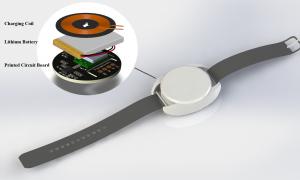Biomedical Engineer Designs Wrist-Worn Remote-Monitoring Device to Ease Hospital Burden
Innovative low-cost wearable integrates sensors and wireless technology to support continuous patient monitoring and reduce emergency department overcrowding
PRISHTINA, KOSOVO, October 22, 2025 /EINPresswire.com/ -- Electrical engineer Drin Rrmoku, an independent researcher focused on biomedical electronics, has developed a compact wrist-worn device designed to help hospitals manage patient loads through continuous remote monitoring.The concept, recently detailed in Rrmoku’s peer-reviewed publication in Cureus (Springer Nature Group), combines heart-rate, body-temperature, and blood-oxygen sensors with motion and fall-detection capabilities. Data are transmitted wirelessly to a smartphone application for real-time visualization, notifications, and alerts for abnormal readings.
“I designed this device to make continuous patient monitoring affordable and effortless, especially in emergency-care settings,” said Drin Rrmoku.
The system integrates wireless charging, a sealed lithium battery, and a capacitive wear-detection feature to improve usability and extend runtime beyond seven days on a single charge. By pairing low-cost components with ergonomic design, the prototype demonstrates how smart wearables can help reduce unnecessary hospital visits and enable early interventions for at-risk patients.
Rrmoku’s proof-of-concept addresses long-standing issues in wearable healthcare systems, including limited comfort, short battery life, and lack of real-world usability. The modular circuit integrates key components such as the MAX30102 for heart-rate and SpO₂ measurement, the MAX30205 for body temperature sensing, and the NINA-B306 microcontroller for Bluetooth Low Energy communication. A digital accelerometer enables fall detection and motion tracking to assist caregivers in monitoring patient activity and safety.
According to Rrmoku, the device was developed with practical adoption in mind. “The goal was to build something realistic and affordable that hospitals or caregivers could use daily without technical barriers. Every design decision from power management to data transmission was made with long-term usability in focus,” he explained.
Rrmoku’s approach highlights the growing potential of accessible medical technology in resource-constrained environments. His ongoing work explores optimizing battery performance, refining sensor calibration, and expanding connectivity for future clinical validation and integration into telehealth platforms.
The article “Reducing Emergency Department Strain Through Usable Wearables: A Proof-of-Concept for Multi-Sensor Remote Patient Monitoring” is available in Cureus and indexed on PubMed. The research demonstrates how accessible biomedical design can contribute to alleviating overcrowding in emergency departments while improving continuity of care for remote patients.
Drin Rrmoku
Independent Researcher
email us here
Legal Disclaimer:
EIN Presswire provides this news content "as is" without warranty of any kind. We do not accept any responsibility or liability for the accuracy, content, images, videos, licenses, completeness, legality, or reliability of the information contained in this article. If you have any complaints or copyright issues related to this article, kindly contact the author above.

